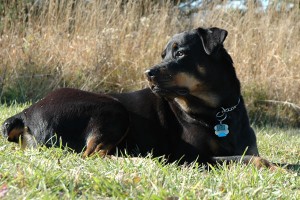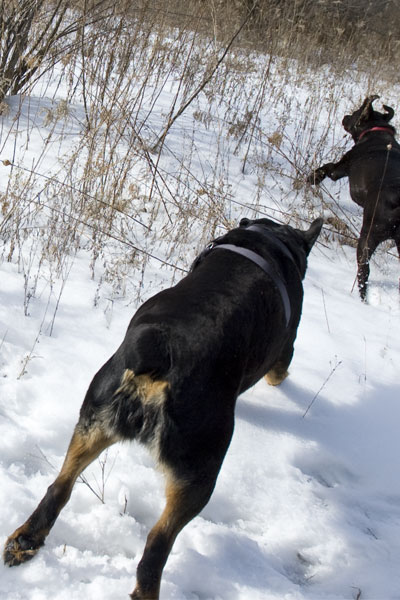Jasmine’s Bilateral ACL Injury
By Jana Rade
When Jasmine started limping in the summer of 2008 we didn’t think too much of it. It wasn’t the first time it happened and it wasn’t the worst either. Jasmine had injured her hind legs three times before and, each time, after an exam and x-rays, we were told it’s probably just soft tissue injury and sent home with recommendation of restricted exercise. Each time it did seem to have resolved on its own eventually.
With passing weeks I started to feel that perhaps we should take her to the vet again after all. It wasn’t getting worse, but it wasn’t getting better either, and Jasmine was showing less enthusiasm for exercise, which hasn’t happened before and wasn’t like her at all.
At the beginning of September we took her to her vet at the time. He didn’t really find anything and couldn’t elicit the drawer sign but suggested an appointment with an orthopedic specialist just to be sure. He mentioned the words ACL injury and that was the first time ever we heard about such thing.
After I researched what an ACL tear was I really didn’t want it to be it. Jasmine was putting some weight on the leg even though she was limping heavily, particularly after rest following exercise. She wasn’t holding her knee up as would be typical, so I was being hopeful.
However, after her visit with the specialist, and a set of x-rays, the diagnosis was in and it was breaking my heart. Yes, Jasmine did indeed have a partial ACL tear in her left leg, and if that wasn’t enough, her right knee didn’t look so great either. The recommendation was to do a TPLO surgery on the left knee immediately, with a prospect of another surgery once that heals. When I’ve learned what TPLO was I didn’t like it the least bit.
To Jasmine, her legs are the most important part of her body! They take her places! Such an invasive surgery and six months recovery … taking almost a whole year out of her life … I really didn’t want to do that if I could help it.
I spent endless hours researching and looking high and low for other options. We considered conservative management with knee brace. But Jasmine was only 5 years at the time and she is a very active dog. Brace didn’t sound like a good solution for her.
I was talking to many people and many vets and one vet from Australia mentioned that prolotherapy might be a solution for a partial ACL tear. I researched that and it sounded hopeful, and certainly better than a surgery. I found a vet in our region and discussed that with her. She said that it could be an option. Before we booked a consultation with her I brought it up to Jasmine’s vet. He didn’t know much about it, looked it up quickly and figured it was a terrible idea. There he was saying things such as bone infection and amputation … scared the living daylights out of me.
I did talk to a number of vets who successfully used this technique prior that conversation, but the word amputation eclipsed all the positive things I read and heard. I called the consulting vet immediately and told her what Jasmine’s vet thought. She was trying to explain that while there is some degree of risk they take precautions and it is very safe. As she noticed I wasn’t really hearing that suddenly she suggested something else:
“Well, we could also try stem cell regenerative therapy. It really is a shortcut to what the prolotherapy is designed to achieve.”
Stem cell therapy? Ok, a new word that didn’t have the word amputation tied to it. I asked her how it worked and she gave me the skinny. This certainly sounded interesting!
So back to research. The more I was reading about what stem cells were, the more exciting the whole idea sounded. We discussed it with my husband and he also felt good about it. So back on the phone with Jasmine’s vet.
“Stem cells? From bone marrow?” he asked. “And what about rejection issues?”
“No,” I said, “stem cells from Jasmine’s own fat tissue”.
This time he didn’t even bother looking it up. “Sounds like a scam,” he said.
Well, it didn’t sound like a scam to us. I went back online to see if i could find any testimonials about this treatment in dogs. Didn’t find many, but found some. And more importantly, this felt right. I found a website of the company who is behind this treatment, VetStem. There they had additional information and a list of vets certified for the procedure.
I made a list of those who were the closest and starting calling them. Ideally we wanted to find one who already had experience with this. It turned out that nobody in Canada, or in Ontario anyway, had actually done it yet. As we’d really prefer somebody who did, we decided to call around south of the border. Couldn’t find anybody either. Ok, this was pretty new stuff, huh?
Still though, it did feel right. So back to calling vets near by. The first one who was actually available to talk to me also turned out to be the best vet of them all. He spent at least forty minutes discussing things with me on the phone. He did feel that surgery might be the best option, but was open to the idea. “Knees love being operated on,” he said. “Well, knees might … but what about the dog?” I was thinking.
We booked a consultation. He asked to see the x-rays taken by the orthopedic surgeon but didn’t seem happy that there were only x-rays of her knees. He wanted to see her shoulders and hips also.
We discussed it all again with my husband and figured that we do want to see where the stem cell route might take us. So we booked a consultation with this new vet. We agreed that he’d take his own set. When we brought Jasmine in, he started examining her head to toes.
“Hey, doc, the knees are over here in case you can’t find them,” we thought. But he started explaining how the bad knees would affect other things.
“I want to treat the whole dog,” he said.
Our jaws dropped. “Wow, now there is a novel concept!”
Skipping through a series of events that stemmed from an additional abdominal exam he did while he had Jasmine under to take the x-rays, a cancer scare, and an exploratory surgery, several weeks later we were all set to go ahead with the treatment.
As destiny would have it though, a week before the planned treatment Jasmine came home and was limping really badly, not using her left leg at all. We took her in immediately and our fear was confirmed, her ligament was now totally gone.
So there we were, back to the drawing board. Do we have to do the TPLO after all? (Personally I’d liked the TTA better, but there was no surgeon in Ontario doing that.) Her new vet brought up the option of an extracapsular repair as less invasive. That confused things further, because we have already discarded this option at the beginning, after reading many articles on how bad this option is for large breed dogs.
However, this new vet already got a lot of our trust in the meantime and he has done this surgery successfully on large dogs many times in the past. I asked him the main question: “Is this what you would do if it was your dog?” He said that all things considered yes, he would. I was still a bit uneasy about potential failure of the repair, but it was substantially less invasive…
With that decided we didn’t feel like abandoning the stem cell therapy idea though. Perhaps it could save her other knee? And while at it, it could maybe help the operated knee heal better?
And so it was all set. The first day her vet did the extracapsular repair and extracted a bit of Jasmine’s fat tissue and sent it to VetStem to be processed. Two days later he injected the stem cells into both of her knees, shoulders (which developed arthritis as she was compensating for her bad hind legs) and gave her one IV dose of stem cells also to help our areas that couldn’t be injected).
The first month post treatment he seemed rather disappointed, as he couldn’t see any difference the stem cell treatment would have been making. By the second month though, he started to get really excited. We couldn’t really tell, because we had nothing to compare it with. All along we were just praying that her right leg would hold up through all that. At the end of the second month Jasmine was hardly limping at all, and the third month she was getting the bounce back into her gait. Now it started to get really exciting!
So of course, as a number of times before, just when we were so happy how well things were going, three months after the first surgery, Jasmine’s right knee just went. She didn’t do anything crazy or out of the ordinary. Just boom and there it was. That was really disappointing.
So back on the operating table. However, what the stem cells did for healing from the first surgery was incentive enough that we decided to use it again with the second operation. Her operated leg was strong and in good enough shape to get Jasmine through without a glitch.
Today, about two years after her knee surgeries and stem cell treatments, Jasmine’s legs are as good as new. Her knees are strong and no arthritis is bothering her at all. Her shoulders, which were very broad before, are now in the right proportion again. She has full range of motion and perfect muscle mass. She can run and jump as if nothing ever happened. It’s us who keep slowing her down, still so worried about her.
If we could go back in time, we wouldn’t have done anything differently.
Yes, the stem cells didn’t save her right knee. This treatment can be successful in treating ligament injuries, but it depends on the type and degree of the injury, and of course hopping on the treated leg as she had to do with the left knee surgery, wasn’t the ideal scenario. We are thankful that the right leg held up as long as it did. Normally it is recommended that the stem cell treatment for ACL injury is combined with rest, restricted exercise and external stabilization of the knee (brace). That was not an option in Jasmine’s case.
We are however big advocates of both extracapsular repair and stem cell regenerative therapy. We are happy that Jasmine has her life back!
– Guest Post by Jana Rade of Dawg Business
I have gone to the dogs! 🙂 Graphic designer by profession, I became a dog mama by design. My first puppy, Jasmine, changed my life completely, and now everything I do revolves around her. Her lovely face made me learn about dogs, dog behavior and needs. The unfortunate hand she’s been dealt made me learn a lot about dog health issues. Jasmine has her own ranch, her own dog and a crew of vets helping me take care of her. I couldn’t love her more if she was my own flesh and blood.






I’m a small animal vet in KS (Olathe Animal Hospital) and just wanted to say thank you for sharing Jasmine’s story! I’m so glad she’s doing great, and you have no regrets! I performed stem cell therapy on my own dog (http://olatheanimalhospital.com/1462/monty/ ) and was extremely pleased with the results. We’ve gone on to treat 4 more patients, and we’ve had mixed results. Frank the pug is by far our biggest success (http://www.youtube.com/watch?v=_3mLPJEnOAE )–he’s like a new dog!! One patient developed a spinal tumor (unrelated) 2 months after treatment and had to be put to sleep. One of them was too recent to have any results yet (just treated last week–and it does take at least 30 days to see results!). However, the patient I wanted to mention had a torn ACL, and the point I wanted to make for any readers who might be asking, “Can I do stem cell therapy for my dog’s ACL injury without doing surgery on the knee?” is that surgery IS the best option for the knee! I tried treating my patient with stem cells only and no surgery, and she ended up needing a TPLO anyway. It’s best to do surgery along with stem cell therapy. Great article!
thank you for this- its exactly what my 5 year old pointer mix is going through right now and i’m trying to debate between TTA and TPLO for the one right (100% blown) knee – with a second bad knee approaching — and hips that are deteriorating! Yikes what one week can do! your info and story has helped me think through it all more and i’m appreciative!
[…] not ruptured you might want to look at stem cells as well I know several that swear by the results Bilaterial Acl Canine ACL Tear Stemcell Treatment […]
Who was the vet who did the extra capsular sugeries? I am in Ontario and looking for a good vet for my dog who has bilateral ccl injuries.
[…] Bilateral ACL Injury, Dog Stem Cell for CCL | Dog Knee and Leg … Dog stem cell therapy to heal torn ACL or CCL knee ligament in dogs. Treatment and surgery for dog ligaments torn in … […]
I recently took my 6 year old Bernese in for two blown acl’s the ortho said stem cells. He said this was his recomendation over surgery? I am really worried that stem cells alone wont work I have talked with him about surgery and he insist on stem cell only……..any help on this? I had to go back two days after and plead with them to at least wrap her legs for support and give her some pain meds.. I feel like my hands are tied and I am getting the run around…I paid 1,500 for this and I am really worried about her future….What now and can this work?
Hi Eric, I know it has been years, but what did you end up doing for your dog? I am looking into stem cell therapy for my dog.